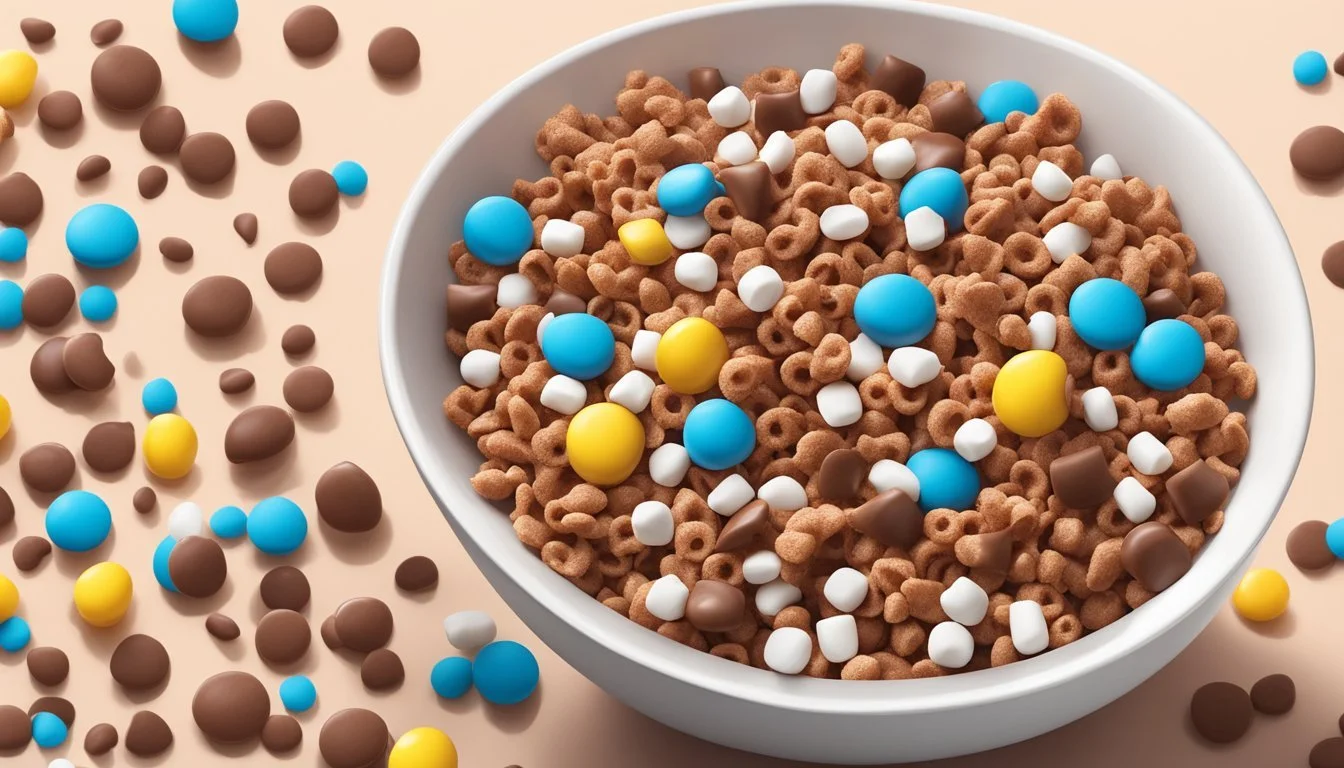Cocoa Krispies vs Kaboom
Comparing Breakfast Cereal Favorites
This Article is Part of Our Breakfast Cereal Guide with Details on Cocoa Krispies Nutrition and Kaboom Nutrition
Breakfast cereals have long been a staple in many households, with both kids and adults enjoying them as a quick and easy meal to start the day. When comparing Cocoa Krispies and Kaboom, it's important to understand the unique qualities each brings to the table. Cocoa Krispies, a chocolate cereal produced by WK Kellogg Co, offers a rich cocoa flavor that appeals to chocolate lovers of all ages. Its crunchy texture and the way it flavors the milk are highlights that many find irresistible.
On the other hand, Kaboom, although not as widely known today, also had its dedicated fan base when it was more commonly found on store shelves. Known for its colorful, fun shapes and sweet flavor, Kaboom brought a different kind of excitement to breakfast. While Cocoa Krispies excels in delivering a concentrated chocolate experience, Kaboom provided a visually appealing and playful option that delighted children.
For those who appreciate a deep chocolate taste in their breakfast cereal, Cocoa Krispies remains a strong contender, whereas Kaboom's unique appeal lay in its vibrant presentation and nostalgic charm. By examining the taste, texture, and overall eating experience both cereals offer, readers can better understand which might be the better choice for their breakfast routine.
Historical Background
Both Cocoa Krispies and Kaboom Cereal have storied pasts that showcase their unique origins and development by their respective companies. Understanding these backgrounds offers insight into their cultural and market significance.
Origin of Cocoa Krispies
Cocoa Krispies, known in various regions as Choco Krispis or Coco Pops, originated from Kellogg's in 1958. This chocolate-flavored variant of Rice Krispies capitalized on the popularity of its original counterpart. The cereal is notable for retaining the classic "snap, crackle, and pop" sounds that made Rice Krispies famous.
Over time, Cocoa Krispies expanded into different formats, including snack bars with dried milk-covered bottoms. Various regional adaptations, like Canada's Rice Krispies Cocoa, ensure that global markets receive tailored versions of this classic cereal.
Kaboom Cereal's Beginnings
Kaboom Cereal, produced by General Mills, first hit shelves in 1969. This colorful marshmallow-dotted cereal was marketed predominantly towards children. Known for its clown mascot, Kaboom aimed to stand out in the competitive breakfast cereal market with its playful imagery and sweet taste.
Despite being discontinued in the mid-2010s, Kaboom has left a lasting impression. Its unique branding and cereal design are often remembered nostalgically by those who grew up with it. This cereal remains a notable example of General Mills' creative approach to the breakfast cereal category.
Nutritional Comparison
When comparing Cocoa Krispies and Kaboom cereals, it is essential to analyze their nutritional components to determine which might be a better fit for different dietary needs and preferences. Key factors to consider include caloric content, vitamin and mineral levels, and the balance of fats, fibers, and sugars.
Caloric Content Analysis
Cocoa Krispies and Kaboom cereals differ significantly in their caloric content per serving. Cocoa Krispies contain approximately 120 calories per 1-cup serving. In contrast, Kaboom cereal offers around 110 calories for a similar serving size.
Though the caloric difference might seem minor, it can add up over time, especially for individuals closely monitoring their caloric intake. Cocoa Krispies might be slightly more suitable for those looking for higher energy content, while Kaboom offers a marginally lower-calorie option.
Vitamins and Minerals Content
Both cereals are fortified with a variety of essential vitamins and minerals, making them beneficial for a balanced diet. Cocoa Krispies provide substantial amounts of Vitamin B1, B2, B6, and B12, along with notable quantities of Vitamin A and Iron. They are particularly high in Vitamin E and Vitamin C.
Kaboom, on the other hand, is recognized for its high levels of Vitamins A, B1, B6, and B12, similar to Cocoa Krispies, but it also contains additional vitamins such as Vitamin D and K. Kaboom might offer a more rounded vitamin profile due to its inclusion of a wider range of vitamins.
Fats, Fibers, and Sugars Breakdown
In terms of fats, fibers, and sugars, Cocoa Krispies contain about 0.5 grams of fat and 12 grams of sugars per serving, with minimal fiber content (less than 1 gram). This makes it a light option in terms of fat but relatively high in sugars.
Kaboom cereal has slightly higher fat content at around 1 gram per serving. It also contains more fiber, approximately 3 grams per serving, which can aid in digestive health. Sugars in Kaboom are similar to those in Cocoa Krispies, at around 11 grams per serving. This makes Kaboom a slightly more balanced choice in terms of fiber and overall fat content, with a comparable sugar level.
Taste and Texture Profile
When comparing Cocoa Krispies and Kaboom, focusing on the taste and texture can help consumers decide which suits their preferences. Consider the chocolate flavor, sweetness levels, and how each cereal feels in the mouth.
Flavor Analysis
Cocoa Krispies offer a mild chocolate flavor that is subtle yet pleasing.
They are less intense compared to cereals like Cocoa Pebbles and Cocoa Puffs.
The taste is gently sweet, which can be ideal for those who do not prefer overly sugary cereals.
Kaboom, on the other hand, provides a fruity taste with a hint of marshmallow sweetness.
Its flavor profile is more diverse and less focused on chocolate, making it a distinct choice compared to Cocoa Krispies.
A blind taste test might reveal that some prefer the simplicity and familiarity of Cocoa Krispies, while others are drawn to the unique blend of flavors in Kaboom.
Mouthfeel and Texture Considerations
Cocoa Krispies have a light and crisp texture.
They quickly soften in milk, which can create a smooth cereal milk that many enjoy drinking after finishing the cereal.
Kaboom features a more varied texture due to its combination of fruity cereal pieces and marshmallows.
The marshmallow pieces add a chewy contrast to the crunchy fruity bits.
Some might find the texture of Cocoa Krispies more consistent and easier to munch on compared to the mixed textures in Kaboom.
Others might appreciate the tactile diversity Kaboom offers, enhancing the overall eating experience.
Consumer Experience
Consumer experiences with Cocoa Krispies and Kaboom differ significantly in areas such as cereal milk drinkability, packaging and branding, and market availability and price.
Cereal Milk Drinkability
Cocoa Krispies offer a unique experience when it comes to milk drinkability. The cereal quickly imbues the milk with a rich, chocolate flavor, creating a delicious chocolate milk that kids especially enjoy.
Conversely, Kaboom, while visually appealing with its colorful shapes, doesn't provide the same level of flavored milk. Its sweet taste is appealing, but it lacks the transformation of milk that makes Cocoa Krispies stand out.
Packaging and Branding
Cocoa Krispies feature the familiar Kellogg's brand, which is well-recognized and trusted by consumers. The packaging with characters like Snap, Crackle, and Pop, appeals to kids and has a nostalgic value for adults.
Kaboom, on the other hand, attracts attention through its vibrant, cartoonish packaging. Though primarily known as a children's brand, it doesn't have the same level of brand recognition as Kellogg's Cocoa Krispies.
Market Availability and Price
Cocoa Krispies are widely available in grocery stores, both large and small. This accessibility makes it convenient for consumers to purchase. Additionally, the price point is generally moderate, making it affordable for most families.
Kaboom, while available in some grocery stores, is less ubiquitous. Its price may vary, often positioning it as a budget-friendly option. However, its limited availability can be a barrier for those looking to buy it regularly.
Health and Diet Considerations
When considering Cocoa Krispies and Kaboom cereals, it's essential to evaluate their impact on health and diet. Both cereals offer different nutritional profiles and may cater to various dietary needs and preferences.
Cereal as Part of a Balanced Breakfast
Cocoa Krispies offer a lighter, crispier texture and are fortified with vitamins such as Vitamin C and calcium. These vitamins are beneficial for maintaining overall health and supporting immune function. However, they are lower in fiber and protein, which are crucial for sustaining energy levels.
Kaboom, in contrast, often provides higher fiber content and includes essential vitamins and minerals. Fiber aids digestion and helps in maintaining a feeling of fullness. The inclusion of protein is also beneficial for growth and overall health.
When choosing between these cereals, individuals should consider what nutrients are lacking in their diet and select the option that best complements their nutritional needs. Pairing either cereal with a source of protein, such as milk or yogurt, can create a more balanced breakfast.
Dietary Restrictions and Options
For those with dietary restrictions, understanding the ingredients and nutritional content is crucial. Cocoa Krispies are known to contain ingredients that are not gluten-free, which can be problematic for those with celiac disease or gluten sensitivities.
Kaboom, on the other hand, might offer gluten-free versions, making it a safer choice for people avoiding gluten. Additionally, Kaboom often contains fewer artificial additives, which can be a significant consideration for those seeking to minimize their intake of artificial colors and flavors.
For individuals looking to reduce their sodium intake, Cocoa Krispies present a slightly lower sodium content compared to Kaboom. Ensuring the chosen cereal fits within personal dietary constraints while still meeting nutritional needs is critical for maintaining a balanced diet.
By scrutinizing the nutritional info and ingredient lists, one can make an informed choice that aligns with their health goals and dietary restrictions.
Brand Perception and Market Impact
Kellogg's Cocoa Krispies and General Mills' Kaboom both hold unique positions in the cereal market, influencing perceptions through marketing strategies, mascots, and overall brand presence.
Public and Market Perception
Cocoa Krispies, a product of Kellogg's, is widely perceived as a staple chocolate-flavored cereal. Its mascot, Snap, Crackle, and Pop, has been central to its brand identity, contributing to a positive reception among families and children. Market analysis shows that Cocoa Krispies is consumed about 1.14 times annually, indicating steady consumer interest.
Kaboom, on the other hand, features a clown mascot and appeals more to a niche audience. Despite a less prominent market share compared to Kellogg's, Kaboom holds nostalgic value for some consumers and is positioned differently due to its unique marketing approach.
Competitor Comparison
When comparing Cocoa Krispies to other chocolate-flavored cereals like Cocoa Pebbles, several differences emerge. Cocoa Krispies is known for its light, crispy texture and ease of consumption, while Cocoa Pebbles has a more intense chocolate flavor and a different texture profile.
Kaboom, compared to both Cocoa Krispies and off-brand alternatives, is more distinct in its presentation and target market. Its marketing strategies often emphasize fun and eccentricity, whereas Kellogg's concentrates on widespread popularity and brand loyalty. Cocoa Krispies has the advantage in price competition, typically being more cost-effective than specialized cereals like Kaboom.






